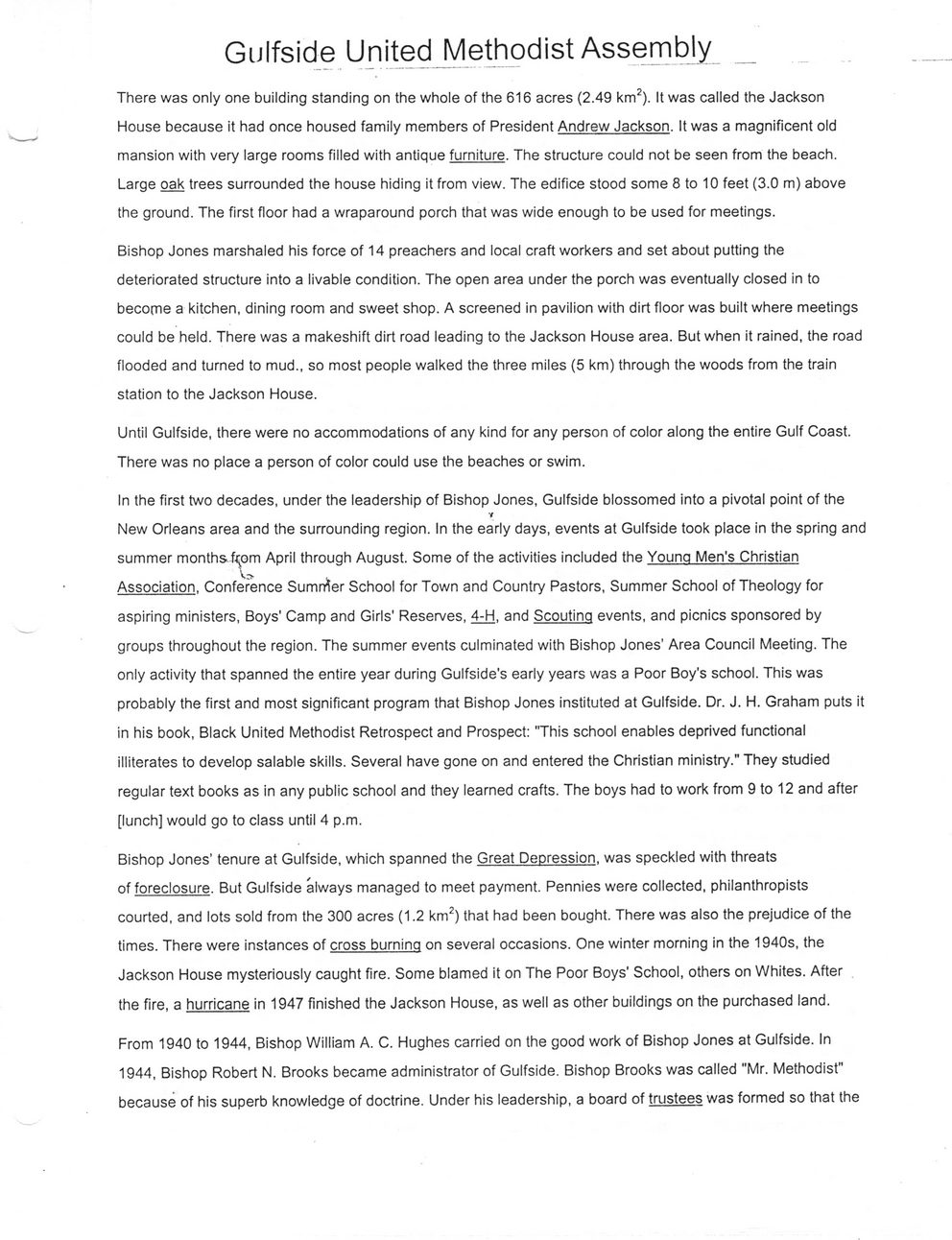This text was obtained via automated optical character recognition.
It has not been edited and may therefore contain several errors.
Gulfside United Methodist Assembly There was only one building standing on the whole of the 616 acres (2.49 km2). It was called the Jackson House because it had once housed family members of President Andrew Jackson. It was a magnificent old mansion with very large rooms filled with antique furniture. The structure could not be seen from the beach. Large oak trees surrounded the house hiding it from view. The edifice stood some 8 to 10 feet (3.0 m) above the ground. The first floor had a wraparound porch that was wide enough to be used for meetings. Bishop Jones marshaled his force of 14 preachers and local craft workers and set about putting the deteriorated structure into a livable condition. The open area under the porch was eventually closed in to become a kitchen, dining room and sweet shop. A screened in pavilion with dirt floor was built where meetings could be held. There was a makeshift dirt road leading to the Jackson House area. But when it rained, the road flooded and turned to mud., so most people walked the three miles (5 km) through the woods from the train station to the Jackson House. Until Gulfside, there were no accommodations of any kind for any person of color along the entire Gulf Coast. There was no place a person of color could use the beaches or swim. In the first two decades, under the leadership of Bishop Jones, Gulfside blossomed into a pivotal point of the New Orleans area and the surrounding region. In the early days, events at Gulfside took place in the spring and summer monthsfijom April through August. Some of the activities included the Young Men's Christian Association. Conference Summer School for Town and Country Pastors, Summer School of Theology for aspiring ministers, Boys' Camp and Girls' Reserves, 4-H. and Scouting events, and picnics sponsored by groups throughout the region. The summer events culminated with Bishop Jones? Area Council Meeting. The only activity that spanned the entire year during Gulfside's early years was a Poor Boy's school. This was probably the first and most significant program that Bishop Jones instituted at Gulfside. Dr. J. H. Graham puts it in his book, Black United Methodist Retrospect and Prospect: "This school enables deprived functional illiterates to develop salable skills. Several have gone on and entered the Christian ministry." They studied regular text books as in any public school and they learned crafts. The boys had to work from 9 to 12 and after [lunch] would go to class until 4 p.m. Bishop Jones' tenure at Gulfside, which spanned the Great Depression, was speckled with threats of foreclosure. But Gulfside always managed to meet payment. Pennies were collected, philanthropists courted, and lots sold from the 300 acres (1.2 km2) that had been bought. There was also the prejudice of the times. There were instances of cross burning on several occasions. One winter morning in the 1940s, the Jackson House mysteriously caught fire. Some blamed it on The Poor Boys' School, others on Whites. After the fire, a hurricane in 1947 finished the Jackson House, as well as other buildings on the purchased land. From 1940 to 1944, Bishop William A. C. Hughes carried on the good work of Bishop Jones at Gulfside. In 1944, Bishop Robert N. Brooks became administrator of Gulfside. Bishop Brooks was called "Mr. Methodist" because of his superb knowledge of doctrine. Under his leadership, a board of trustees was formed so that the

Amish 26